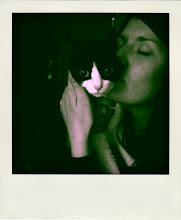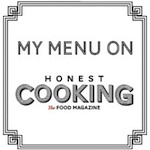When I was a kid, pancakes were something between American-style hotcakes and crepes; they were tender but not fluffy, rollupable but not fragile. We had them with lemon juice and sugar. Sometimes at other kids’ houses they were rubbery and bland and spread with jam I didn’t much care for, but lord knows I ate them anyway. I still like pancakes this way – the way my Mother used to make them – sometimes. But somewhere along the line I discovered the joy of thick, fluffy American-style stacked pancakes, and it pretty much changed what I wanted in a pancake forever.
While there’s room for all kinds of pancakes in this world, what I want is a go-to recipe that produces consistently fluffy, tasty pancakes with a moist and toothsome texture. They should be porous enough to soak up whatever you pour over them, but they should also taste good unadorned. They should be made with stuff that is (usually) already in your fridge and, they should be easy enough to whip up on a Sunday morning after a few too many wines the night before.
I tried around six recipes that used different techniques to achieve the fluffy, tender texture I was after. I tried whipping and folding in egg whites, using buttermilk, leaving batters to rest for an hour and overnight – even adding soda water. Of course the America’s Test Kitchen Family Cookbook had the answer all along – and it was so, so simple: buttermilk + minimal mixing = tender, awesome pancakes. When I say minimal mixing, I mean there’s still lumps and bumps in that batter when you pour it into your greased pan. There’s science here: the less you mix the batter, the less chance the gluten in the flour has to develop that chewiness that is so good in bread, so bad in pancakes. So knead, knead, knead your bread, lovelies – but mix your pancake batter like a kid with no patience. And pour on syrup like there’s no tomorrow.
Best basic pancakes
Recipe from America’s Test Kitchen Family Cookbook, pancake FAQ by me
*This version of recipe is for when you don’t have buttermilk on hand; if you do, simply replace the milk with buttermilk and disregard the lemon juice
Makes around 12 pancakes
2 cups milk
1 tbsp lemon juice
2 cups plain flour
2 tsp baking powder
½ tsp baking soda
2 tbsp sugar
½ tsp salt
1 egg
3 tbsp butter, melted
butter, to grease pan
1. To make buttermilk, stir lemon juice into milk and set aside to thicken.
2. Combine flour, baking powder, baking soda, sugar and salt in a large bowl and whisk to combine.
3. In a smaller bowl, whisk egg with melted butter, then add buttermilk and whish gently until just combined.
4. Make a well in centre of dry ingredients and pour in buttermilk mixture. Whisk very gently until just combined; mixture will be lumpy and uneven.
5. Heat pan to medium hot and add a small knob of butter. Pour 1/3 cup batter into pan. When bubbles appear on the surface of the batter, flip pancake to cook other side. Repeat with remaining batter, greasing pan when necessary.
Pancake FAQ
What should I cook my pancakes in?
The best pan for cooking pancakes is something nice and heavy, like a cast iron skillet. This is because it will distribute and retain heat evenly, cooking your pancakes beautifully every time. I use an enameled cast iron skillet and find it needs very little greasing. Just make sure you heat the pan adequately and test before you start cooking, as they can take a while to get to the right temperature.
Can I add things to this recipe to make other kinds of pancakes?
Why, yes – yes you can. I’ve had great success with this recipe and the following variations: add ricotta, blueberries or both (either in the batter, or sprinkled on once poured into pan); make wholemeal/wholegrain pancakes – simply replace one cup of plain flour with wholemeal; add slices of banana to poured pancake before flipping; add grated cheese to batter for a crispy, crispy surface. This is a very adaptable recipe, so try whatever your heart desires.
What’s the best way to keep the cooked pancakes warm while I finish cooking the rest of the batch?
The America’s Test Kitchen Family Cookbook has this covered, too. I use their suggestion here, which is to preheat your oven on a low setting and put a wire cooling rack over a baking tray/sheet in it. When each pancake is done, place it on the rack in the oven, trying your best not to overlap with other pancakes. This keeps the little babies warm and stops them from loosing their fluffiness and being flattened under the weight of one another.
How long will the batter keep?
The batter will keep a couple of days in the fridge, should you wish to use any remaining the following morning or for dessert. Pour into a jug and cover before placing in the fridge.
Can I freeze cooked pancakes?
Surprisingly, yes! Ok, so maybe it’s only a surprise for freezer-dummies like me. To do this, let the cooked pancakes cool to room temperature before wrapping well (double-wrap will help prevent freezer burn) in plastic wrap and popping in the freezer. ATK says they’ll keep well for a week here and I can’t say any different, cause all mine got eaten within the week. To reheat, defrost in the fridge overnight then warm in a moderate oven for around 5 minutes.
Where can I read more on pancakes?
Have you gone mental? Ok. Deb at Smitten Kitchen has a great guide to pancakes. I’d go there first.










In my house, pancakes for Sunday breakfast always meant a huge Dutch Baby Pancake cut into quarters, topped with lemon and sugar. Oh how I longed for fluffy pancakes like this! Except whenever I ate them, I realised I didn't much like those either, just the maple syrup on top :P
ReplyDeleteThis post is too provocative for a family-friendly web site. In fact, it is practically indecent - it makes innocent, impressionable ones feel like wanting to slip into that pancake with you. Please consider taking it down!
ReplyDelete- R.E.V. De Nile (long-time follower, first-time commentator)
Yeah Hannah, so pancakes many are only good as maple syrup vehicles. I think these ones stand up pretty well on their own though.
ReplyDeleteAnd Dear R.E.V. De Nile, this isn't a family-friendly website and it never will be. Just wait til I blog about the souffle...
I'm hoping to try this pancake recipe soon! I never fully appreciated the need for minimal stirring...
ReplyDeleteI frequently freeze cooked waffles and just re-heat them in the toaster...I wonder if the same would work for pancakes?
Hope they turn out super-fluffy like mine did!
ReplyDeleteYeah, I was wondering if you could toast pancakes too. I'm pretty sure they'd be fine, as long you didn't mind them coming out a little more toasty than steamy. Let me know if you try it!